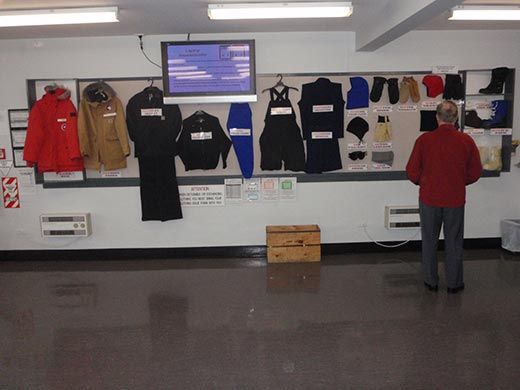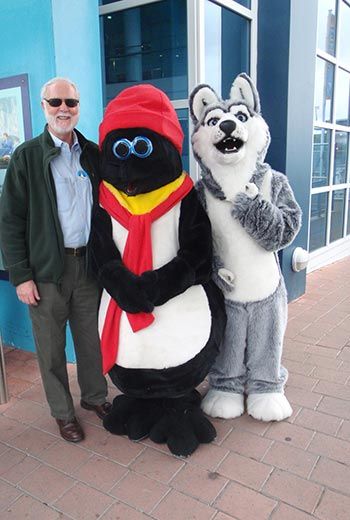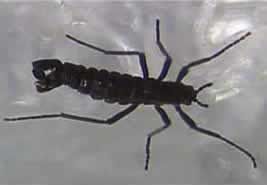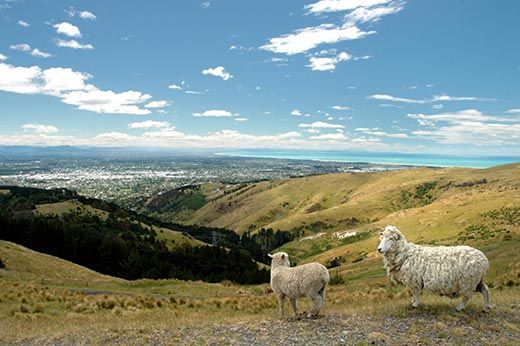Day 1: A Stopover in New Zealand
As the first Smithsonian secretary to set foot on Antarctica, Secretary Clough prepares for his trip from a research center in Christchurch
/https://tf-cmsv2-smithsonianmag-media.s3.amazonaws.com/filer/Christchurch-New-Zealand-631.jpg)
Jan. 15- Jan. 18, 2010, Christchurch, New Zealand
It is not often in life you get a second chance. We’ve all turned down opportunities at some time in our lives, only to find that they are never offered again. One of my own regrets has been once missing out on a chance to take a trip to the Antarctic because of other commitments. So last fall, when I was offered a second chance to go to the Antarctic with a small group of scientists and engineers, I jumped at the opportunity! And this time I have even more justification because of the Smithsonian’s long and distinguished history of involvement with the science of the Antarctic.
Getting to this majestic continent today is a lot easier than it was for the great British sea explorer, Captain James Cook, who in 1773 became one of the first explorers to cross the Antarctic Circle, opening the way for the many who would follow. His voyage took three years, and it still takes a bit of an effort to get to the Antarctic today. I left Washington, D.C., on Friday, Jan.15, and didn’t arrive in Christchurch, New Zealand, until more than 24 hours later.
Christchurch is the home of the United States/New Zealand polar logistics center and is the jumping-off point for the flight to Antarctica. Flying to New Zealand, you pass over the International Dateline, and in the blink of an eye, lose a day of your life. So, we arrived in Christchurch on Sunday, having lost Saturday altogether. The good news is that you get a day back on the return trip. I don’t think I’ll get back that particular Saturday, but it’s still comforting to know I’ll wind up even-steven.
Our group of travelers includes our host, Dr. Arden Bement, director of the National Science Foundation; Dr. Tom Peterson, assistant director for engineering, NSF; Dr. Karl Erb, director of the Office of Polar Programs, NSF; Dr. Kristina Johnson, Under Secretary of Energy, Department of Energy; and Dr. Steve Koonin, Under Secretary for Science, DOE. The NSF is responsible for funding and managing U.S. research activities in Antarctica. Its role is essential as an “honest broker” in funding a large number of peer-reviewed programs each year and coordinating the Antarctic research of other entities, including the Smithsonian. I am fortunate to serve as a member of the National Science Board, the governing board for NSF.
Other U.S. government agencies are involved in the Antarctic as well. The Defense Department provides logistics for this challenging area of the world, including all flights to and from the continent and the single annual visit made to McMurdo Station by a supply ship. The Department of Transportation is responsible for providing ice breakers to lead in the supply ship and to assist other research vessels as needed. Finally, the State Department formulates U.S. foreign policy for all of the programs in the Antarctic. This policy conforms to the remarkable Antarctic Treaty, which has been signed by 43 nations, agreeing to avoid militarization or commercialization of the Antarctic. The treaty, first ratified by 12 nations in December 1959, was to be in effect for 50 years and then reconsidered. The reconsideration process was kicked off by a meeting at the Smithsonian last fall where I was privileged to introduce Prince Albert of Monaco, who has developed a strong personal interest in preserving the Antarctic for future generations.
After arriving in Christchurch on Sunday, I spend most of the day resting and reading up on the Antarctic. The Smithsonian has a geographic connection to the Antarctic through the Wetmore Glacier, named after SI’s sixth Secretary Alexander Wetmore, who served from 1944 to 1952. Although Secretary Wetmore himself never visited the Antarctic, he supported and facilitated expeditions there, including one by polar explorer Finne Ronne conducted in 1947 and 1948. During the expedition, Ronne discovered a new glacier and named it for his friend, Secretary Wetmore. I feel very privileged to be the first Secretary to visit the continent and look forward to the continuation of my journey.
Just some of the gear required for a summer vacation at the South Pole. Our second day in Christchurch requires us to spend time at the International Antarctic Centre near the airport. Here, we are outfitted with cold-weather gear and given instructions about safety. For example, it is important to be careful when using a camera in extreme cold because your fingers can freeze to the metal parts of the camera. Just the thought of that happening is certainly an attention-getter. We are advised to take altitude sickness pills because, although the South Pole is only about 7,000 feet in elevation, it will feel as if we’re at 10,000 feet. The cold-weather gear the Centre outfits us with is an entirely different level of protection than one would normally think about for skiing or other winter activities. There are long johns and then there are extreme long johns. By the time you’re bundled up in all the layers and a big jacket, it’s hard work just to see your feet. This is all serious business and I listen carefully. These folks know what they are talking about and I have no experience with anything as cold as I will experience on this trip.
We are given two large orange duffle bags for our gear and any clothes we will take with us. Since this is Antarctica’s summer, the temperature at McMurdo Station will be only a bit below freezing, and when in camp, we can wear our regular clothes with some precautions.
After we are outfitted, we take some time to visit the museum and education center at Centre. This is a popular venue for schoolchildren where they can learn about the Antarctic from excellent exhibitions and live displays of penguins. The place is packed with children and their families. There is even a cold room where visitors can don special clothes and get a feel for conditions at a place like McMurdo, including blowing snow. The children love this and it is truly educational.
The remainder of the day is spent reviewing materials for the trip and packing our duffles. Rise and shine around 5:30 a.m. for the five-hour flight tomorrow morning. Exciting!
Here are a few facts about the unique place I will be seeing tomorrow for the first time:
1. The Antarctic is the coldest, windiest and driest place on the face of the earth. Temperatures average 70 degrees F below zero and have plunged as low as -129 F. Six to eight inches of precipitation measured in water equivalent falls on the Antarctic, and in the Dry Valleys, no rain has fallen for 2 million years.
2. The continent is the fifth largest of the seven continents of the world and is larger than the United States and Mexico combined.
3. All but 2.4 percent of the continent of Antarctica is covered by an ice sheet that averages more than a mile in thickness and in some places reaches three miles thick. The ice sheets contain up to 70 percent of the world’s fresh water.
4. If the ice sheets were to melt, sea level would rise more than 200 feet around the globe and Antarctica itself be elevated more than 500 feet because of the relief from the weight of the ice.
5. There are no trees in Antarctica and the largest terrestrial animal is the wingless midge (Belgica antarctica), a tiny fly less than one-half of an inch long.
6. The Antarctic continent itself was not sighted until 1821 and the first man to reach the South Pole was Roald Admundsen, a Norwegian explorer, in 1911.
7. Here’s a good one. The Antarctic was not always cold. Some 200 million years ago, the land masses that were to become South America, Africa and the Antarctic were linked as Gondwanaland, a southern supercontinent that eventually split up. The part of Gondwanaland that was to become part of Antarctica was warm and tropical plants and animals flourished. Assembling the Antarctic into a separate continent was the work of millions of years of plate tectonics and plate movements. The eastern part of the present continent is much older than the western part, with the two separated by the Transantarctic Mountains.
8. The Antarctic as we know it today is about 20 million years old at which time it became completely surrounded by the sea. The Antarctic, a continent surrounded by water, differs from the northern Arctic, which is floating ice surrounded by land.
9. And, I saved the best for last: According to the International Antarctic Centre, hair grows at twice the rate in the Antarctic as it does elsewhere on the planet.
/https://tf-cmsv2-smithsonianmag-media.s3.amazonaws.com/accounts/headshot/wayne-clough-240.png)




/https://tf-cmsv2-smithsonianmag-media.s3.amazonaws.com/accounts/headshot/wayne-clough-240.png)